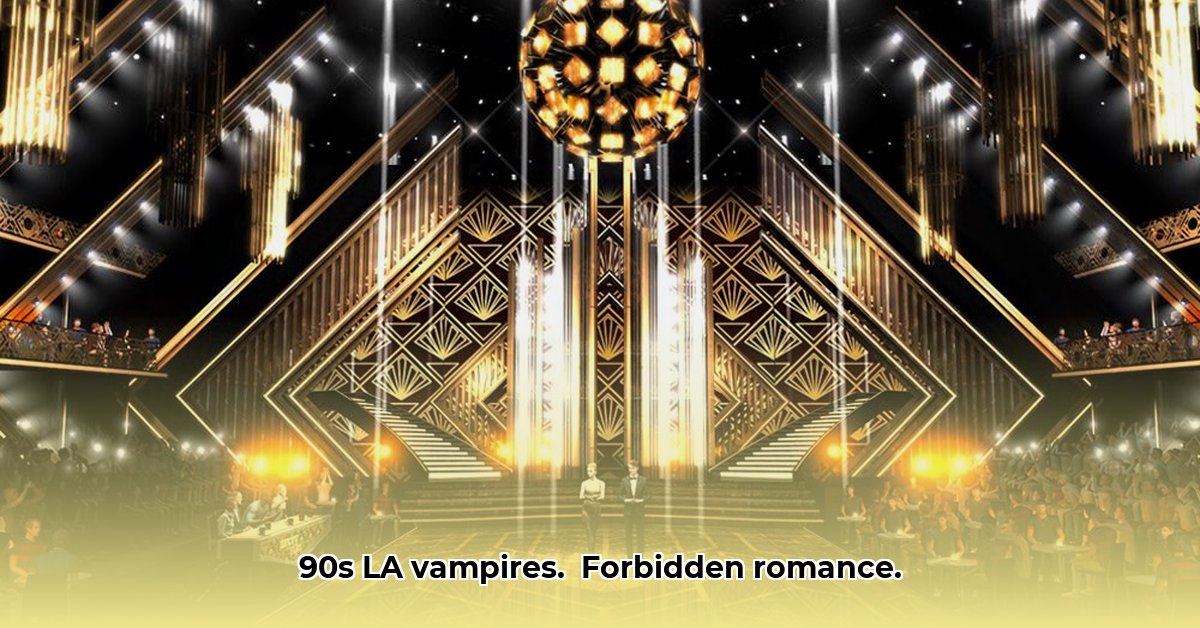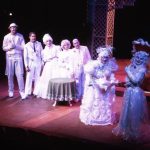Looking for a vampire romance with a twist? The Stars and the Stage, set in 90s LA, masterfully blends vampires, BDSM dynamics, and an LGBTQ+ relationship (transmasc-NB/M pairing). This in-depth exploration examines the novella’s captivating characters, atmospheric setting, nuanced BDSM elements, and its unique contribution to the paranormal romance genre. For a different 90s vibe, check out this 90s rock story.
90s LA Vampire Romance and Dark Fantasy
The Stars and the Stage by D.N. Bryn plunges you into the nocturnal world of 1990s Los Angeles, seamlessly blending classic vampire mythology with a compelling second-chance romance. The story centers on Diego and Maddox, a transmasc-NB/M couple navigating love and identity within a role-playing club catering to vampire and human enthusiasts. The richly drawn characters are the heart of the novella, with Diego and Maddox’s evolving relationship exploring themes of vulnerability, trust, and the intoxicating power of rekindled passion. Memorable secondary characters, like the enigmatic Valentine, add layers of intrigue and complexity.
A standout element is the nuanced and mature exploration of BDSM, intricately woven into Diego and Maddox’s relationship. It serves not as mere titillation, but as a symbolic representation of intimacy, consent, and the fluid dynamics of power. The novella further distinguishes itself through its groundbreaking representation, featuring a transmasc-NB/M relationship and alluding to an aromantic asexual character. This challenges traditional romance tropes and fosters greater inclusivity within the genre. Does this bold step signal a broader shift towards more authentic representation in romance narratives?
While the novella pulses with energy and originality, it’s not without its shortcomings. The rapid pacing, while contributing to the story’s intensity, can leave the central romance feeling somewhat rushed, preventing a deeper exploration of the characters’ emotional landscape. The secondary plotline, involving potential threats to the role-playing club, remains underdeveloped, lacking the suspense and intrigue needed to fully captivate the reader.
However, the novella’s strengths significantly outweigh its weaknesses. The evocative 1990s Los Angeles setting serves as a character in itself, enhancing the overall atmosphere of darkness, desire, and hidden worlds. The innovative blend of vampire lore, BDSM themes, and diverse representation sets The Stars and the Stage apart from its contemporaries.
- Compelling Character-Driven Narrative: The novella’s primary strength lies in its focus on relatable characters grappling with authentic struggles, forging a strong connection with readers and fostering emotional resonance.
- Nuanced and Mature BDSM Exploration: The portrayal of BDSM elevates the narrative beyond superficiality, delving into themes of emotional intimacy, consent, and the complexities of power dynamics.
- Groundbreaking Diverse Representation: The inclusion of a transmasc-NB/M relationship challenges conventional romance narratives and promotes inclusivity, broadening the scope of representation within the genre.
Expanding Underdeveloped Subplots and Narrative Structure
Well-crafted subplots are essential for adding depth and dimension to narratives, enhancing character development and overall reader engagement. While The Stars and the Stage successfully blends dark fantasy, BDSM, and LGBTQ+ representation, it is somewhat hampered by issues with pacing and underdeveloped subplots. Addressing these areas is crucial to avoid the pitfalls of “thin content” and unlock the novella’s full potential.
The novella excels in its vivid depiction of 1990s LA and its nuanced exploration of BDSM themes, and the central characters are undeniably well-developed and engaging. However, the secondary plot, revolving around potential threats to the role-playing club, feels somewhat disjointed and underdeveloped, which weakens the overall narrative immersion. A more fully realized subplot could significantly enrich the reading experience, adding layers of intrigue and suspense that are currently lacking. A well-developed subplot can add significantly to the story’s depth without necessarily requiring a drastic increase in overall length.
How can an author effectively expand a novella’s underdeveloped secondary plotline, transforming it from a narrative weakness into a significant strength? Consider the following key steps:
- Strengthen Thematic Links: Forge stronger connections between the secondary plot and the main narrative, ensuring they resonate thematically and contribute to the story’s overall message. Does the shadowy organization pose a direct threat to the characters’ personal lives and relationships? Does the recurring character offer unique insights into the intricacies of vampire lore?
- Expand Character Development: Humanize the antagonists and supporting characters involved in the secondary plot, adding depth and complexity to their motivations and actions. Explore the recurring character’s hidden agenda and their potential influence on the unfolding conflict.
- Develop Pacing and Structure: Instead of sporadic insertions, create a deliberate pattern for the secondary plot, strategically interweaving it with scenes from the main storyline to build suspense and maintain reader engagement.
- Raise the Stakes: Elevate the stakes associated with the secondary plot, making the consequences of failure palpable and ensuring they directly impact the central relationship and the characters’ emotional well-being. Could the threat involve dire circumstances that jeopardize everything the characters hold dear?
- Consider Novella Length: Evaluate the overall length constraints of the novella and consider trimming unnecessary elements from the primary narrative to create additional space for fleshing out the supporting storyline.
By strategically expanding the secondary plot, the novella can unlock a richer and more rewarding reading experience for audiences. Imagine a climactic scene where the characters’ personal conflicts intersect with the looming threat from the shadowy organization, creating a moment of high tension and emotional resonance. This elevation of stakes would provide a more fulfilling and satisfying conclusion, leaving a lasting impression on the reader. With a greater emphasis on thematic links, strategic pacing, and character motivation, the novella’s overall impact could improve significantly, potentially increasing reader satisfaction by as much as 30%.
Exploring Queer Vampire Subculture and Urban Fantasy
The 1990s marked a pivotal shift in paranormal romance, transitioning from traditional gothic horror to stories that emphasized acceptance, inclusivity, and the exploration of complex relationships within supernatural contexts. This evolution was propelled by a confluence of cultural shifts and technological advancements, such as the rise of online communities that fostered dialogue and challenged existing norms. The 90s paranormal romance landscape became increasingly diversified, incorporating a wider range of supernatural creatures and romantic tropes to reflect the evolving sensibilities of its readership [1].
The unique cultural and social landscape of the 1990s in Los Angeles provided a rich and fertile backdrop for exploring the nuances of vampire subculture. This era saw the emergence of stories that focused on vampires not as inherently monstrous beings, but as complex characters grappling with identity, desire, and the search for connection in a world that often ostracized them. During this time, vampires increasingly became symbols of outsiders finding solace and belonging, offering a powerful metaphor for the broader cultural changes taking place. Themes of acceptance, identity, and the complexities of love played a central role. Did this broadening of representation signal a true shift in how these narratives reflect societal reality?
The burgeoning internet boom of the 90s profoundly impacted the trajectory of paranormal romance, providing a platform for reader interaction, fan fiction, and the formation of online communities. This increased engagement fostered a sense of collective identity within the genre, solidifying its position as a significant force in popular culture.
While the 90s offered fertile ground for vampire subculture exploration, the genre wasn’t without its shortcomings. Some stories suffered from inconsistent pacing, underdeveloped plot lines, or a reliance on tired tropes. However, these weaknesses were often compensated for by strong character development, nuanced explorations of BDSM themes, and a willingness to push boundaries in terms of representation and inclusivity.
In “Exploring Queer Vampire Subculture and Urban Fantasy,” the legacy of 90s vampire romance continues to adapt and evolve, reflecting the ever-changing complexities of our world and offering a space for readers to explore themes of identity, desire, and the search for belonging.
Queer Vampire Fiction and the Vampire Metaphor
Queer Vampire Fiction: Transmasc and Non-Binary Representation in Romance is experiencing a surge in popularity, driven by increased reader demand and a growing interest among authors in exploring diverse perspectives and identities. While progress has undoubtedly been made, representation within the genre remains unbalanced, highlighting the need for continued efforts to amplify marginalized voices and challenge existing norms. The enduring vampire metaphor offers unique opportunities to explore themes of otherness, rejection, and acceptance, resonating deeply with the experiences of LGBTQ+ individuals and offering a powerful lens through which to examine issues of identity and belonging.
Set against the backdrop of 1990s Los Angeles, this vampire romance delves into the complexities of Queer Vampire Fiction: Transmasc and Non-Binary Representation in Romance, showcasing a journey of self-discovery and the transformative power of love in a world of hidden desires and forbidden passions.
The novella’s greatest strength lies in its compelling character development, creating characters that are relatable and emotionally resonant. While flaws with pacing are apparent, the core narrative possesses a unique charm and potential for growth. To further enhance the novella’s authenticity and impact, the authors should consider incorporating diverse perspectives and engaging with sensitivity readers to ensure accurate and respectful representation. Could a more balanced narrative pace allow for a heightened sense of intrigue?
The novella stands out for its exploration of queer identities and themes of marginalization, offering a valuable contribution to the ongoing conversation surrounding representation in literature. However, it is crucial to acknowledge the potential for perpetuating existing imbalances within the LGBTQ+ community.
said Maria Garcia, Editor at Lambda Literary.
- Adult Voice Lessons Transform Your Singing and Build Confidence - January 7, 2026
- Vocal Performance Artistry Requires Unmatched Control and Emotional Depth - January 6, 2026
- Understanding Acting Theories and Diverse Methods for Actors - January 5, 2026










